Approach
Ebola disease is a notifiable disease. The mainstay of treatment is early recognition of infection coupled with effective isolation and optimised supportive care in a hospital setting.
High case fatality rates may be related to the supportive care available in resource-poor, rural settings where outbreaks have occurred, and reflect the difficulties patients in these settings have in accessing basic medical care in a healthcare structure that is overwhelmed.[18][20]
Cases imported to developed countries present a different scenario with comprehensive supportive care available in these settings, including organ support in intensive care units.[45][134] Despite this, the lack of specific, proven therapies means that fatalities occur even in developed countries where best supportive care is available.[107][135][136]
There was previously an active debate about the suitability of moving patients with advanced disease and a poor prognosis to intensive care where the risk for nosocomial infection may be high. It was thought that failure to provide full supportive care to those who are suspected (but not confirmed) of being infected may result in substandard care for these patients, who may subsequently be shown to have a treatable disease such as malaria. It is now clear that full supportive care can reduce mortality, with a reported survival rate of 81.5% in patients managed outside the West African setting, and that it should be provided whenever possible.[137][138][139] Local hospital protocols should consider how this situation would be handled for patients with suspected infection before possible transfer to the intensive care unit, and for those who have already been transferred there.[115][136][138][140][141]
[Figure caption and citation for the preceding image starts]: Ward area at an Ebola treatment centre in West Africa, 2014From the personal collection of Chris Lane, MSc; used with permission [Citation ends].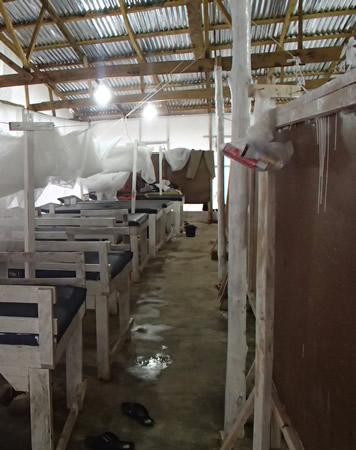
Infection prevention and control
Infection prevention and control (IPC) is of immediate concern and local protocols should be followed. Patients who are identified as being at risk of infection as per the case definitions should immediately be isolated and personal protective equipment (PPE) should be used until the infection is either confirmed or excluded.
The WHO recommends the following IPC principles in healthcare settings.[92]
An IPC ring approach is recommended in healthcare facilities and communities during the management of cases.
In geographical areas where the virus is circulating, all people should be screened at the first point of contact with a healthcare facility, using a no-touch technique, to enable early recognition of suspected cases.
All suspected cases should be triaged to determine the severity of disease and identify patients in need of immediate care.
Patients with suspected or confirmed infection should be isolated, preferably in a single room.
Interaction with family and visitors should be facilitated to promote wellbeing, while preventing direct contact with others.
Hand hygiene should be performed using an alcohol-based hand rub or soap and running water using the correct technique.
Bleach/chlorine solutions may be used in emergency situations when these methods are not available until they become available.
Appropriate PPE should be worn when in contact with a suspected or confirmed case.
Mucous membranes of the eyes, mouth, and nose should be completely covered. A face shield or goggles (under the head-and-neck covering) should be used. Fluid-resistant surgical or medical masks with a structured design (so that they do not collapse against the mouth) are recommended. A fluid-resistant particulate respirator should be used during aerosol-generating procedures.
Gloves and a disposable gown (or coverall) and apron made of fabric that has been tested for resistance to penetration by body fluids or blood-borne pathogens should be worn. Nitrile gloves are preferred over latex gloves.
Specific PPE requirements depend on the level of patient contact (i.e., indirect contact such as screening and triage versus direct contact of a case). PPE is not required during screening activities where a distance of at least 1 metre can be guaranteed and a no-touch approach is strictly followed.
Surfaces should be disinfected (using the wiping method) in facilities and settings that provide care to patients with suspected or confirmed infection.
All waste generated from the care of a patient with suspected or confirmed infection should be treated as infectious waste.
Heavily-soiled linens from patients should be disposed of safely (e.g., incinerated).
Healthcare workers with occupational exposure should be immediately assessed for exposure risk and managed accordingly.
The WHO suggests exclusion from work for 21 days.
More detailed IPC guidance is available from the WHO:
[Figure caption and citation for the preceding image starts]: Key infection prevention and control measures in the World Health Organisation (WHO) guideline for EbolaWillet V et al. BMJ 2024; 384 :p2811 doi:10.1136/bmj.p2811; used with permission [Citation ends].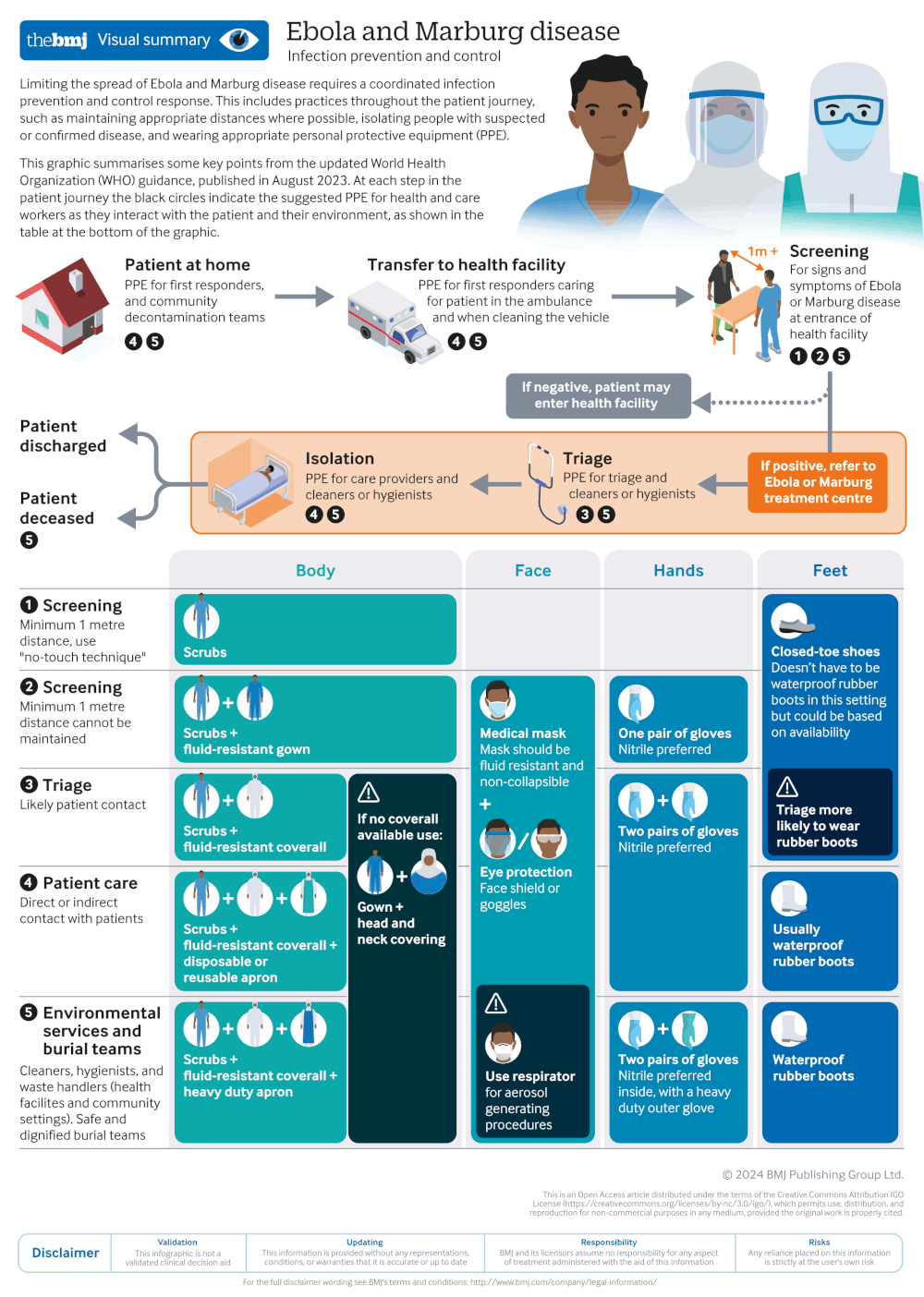
Guidance is also available from the CDC:
Specimens for laboratory investigations (e.g., Ebola RT-PCR, FBC, serum creatinine and urea, LFTs, ABG, coagulation studies, blood cultures, and investigations for other conditions such as malaria) should be collected and sent off according to local and national protocols. Judicious selection of investigations is important in order to reduce risk of transmission to laboratory workers and other healthcare personnel. Placement of a central line early in the patient stay (if possible) allows bloods to be taken and fluids to be given while minimising the risk of needlestick injuries.[142] The WHO and CDC produce detailed guidance on specimen collection:
CDC: collection, transport, and submission for Ebola virus testing in the US Opens in new window[Figure caption and citation for the preceding image starts]: Healthcare worker in personal protective equipment at an Ebola treatment centre in Sierra Leone, 2014From the personal collection of Chris Lane, MSc (Public Health England/World Health Organization); used with permission [Citation ends].

Optimised supportive care
Individualised and optimised supportive care is recommended for all patients.[143][144]
Systematic assessment and re-assessment of patients
Assess vital signs, physical examination, fluid status, and laboratory monitoring. Record and respond to change or abnormal clinical and laboratory parameters.
Patients at high risk of complications: assess at least every hour. A staffing ratio of one clinician for up to two patients is recommended.
Patients not at high risk of complications: assess at least three times per 24 hours (every 8 hours). A staffing ratio of one clinician for up to four patients is recommended.
Assess physical, social, psychological, and spiritual wellbeing on admission and then on a daily basis.
Fluid resuscitation
Oral re-hydration is recommended in patients who can drink.
Parenteral administration of appropriate fluids is recommended in those who are unable to drink or who have severe dehydration, sepsis, or shock.
Vasopressors may be required for shock if fluid resuscitation is not successful.
Electrolyte monitoring and correction
Perform daily biochemistry tests during the acute phase of illness and haematology on admission and as needed, and manage electrolyte derangements as necessary.
Glucose monitoring and management
Check serum glucose at least three times daily with vital signs, and manage with intravenous dextrose as needed.
Management of potential co-infections
Give empirical antibiotics on admission with re-assessment after 48 hours.
Give empiric antimalarial therapy until the malaria testing is negative or the treatment course is finished.
Nutrition
Encourage oral nutrition if possible.
Provide enteral nutrition as tolerated.
Consider intravenous dextrose in patients who cannot tolerate oral food and with evidence of hypoglycaemia.
Symptomatic care
Treat fever, pain, nausea/vomiting, dyspepsia, diarrhoea, anxiety, and agitation.
Prevention and management of complications
Prevent catheter-associated infections and pressure ulcers.
Manage complications, including seizures, encephalopathy, haemorrhage, acute kidney injury,metabolic acidosis, hypoxic respiratory failure, and sepsis/septic shock.
Each patient should be assessed systematically each day using a suitable checklist. An example is available from the WHO.[143] More information on these management principles is detailed below.
WHO: optimized supportive care for Ebola virus disease Opens in new window
Fluid and electrolyte replacement
The high frequency of vomiting and diarrhoea means that patients are often dehydrated and hypovolaemic, particularly if they present late. This is probably responsible for the high case fatality rates in outbreaks as basic clinical monitoring (i.e., temperature, respiratory rate, pulse rate, blood pressure, and fluid input/output) is essential, but often difficult in resource-poor settings.
Oral rehydration solutions can be used for patients who can tolerate oral administration and who are not severely dehydrated, but the majority of patients require intravenous fluid replacement with either normal saline or lactated Ringer's solution.[20][94][Figure caption and citation for the preceding image starts]: Oral rehydration solution supplies at an Ebola treatment centre in West Africa, 2014From the personal collection of Chris Lane, MSc; used with permission [Citation ends].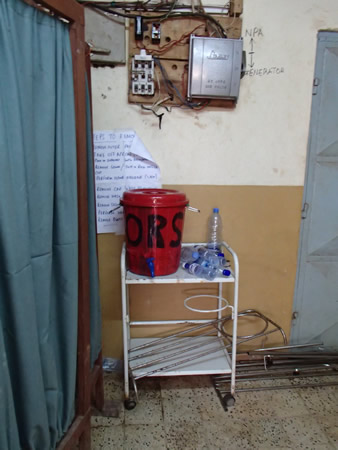 [Figure caption and citation for the preceding image starts]: Insertion of an intravenous line in an adult with Ebola virus disease (West Africa)From the collection of Tom E. Fletcher, MBE, MBChB, MRCP, DTM&H; used with permission [Citation ends].
[Figure caption and citation for the preceding image starts]: Insertion of an intravenous line in an adult with Ebola virus disease (West Africa)From the collection of Tom E. Fletcher, MBE, MBChB, MRCP, DTM&H; used with permission [Citation ends].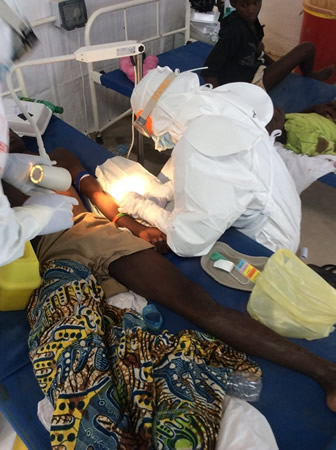
Markers of poor perfusion may indicate poor or inadequate oral intake and patients should be promptly switched to intravenous administration. Options include the peripheral or central intravenous route, or the intraosseous route.[145]
The volume of intravenous fluids required should be assessed based on clinical examination (i.e., level of dehydration, signs of shock) and fluid losses (i.e., volume of diarrhoea and/or vomitus). Large volumes of fluid replacement (up to 10 L/day) may be required in febrile patients with diarrhoea.[45][146][147] Large amounts of potassium replacement (e.g., 5-10 mmol [5-10 mEq/L] potassium chloride per hour) may also be required.[22][134][148]
Close supervision and frequent monitoring are required as it is important to assess response and prevent fluid overload. Patients should be checked frequently for signs of shock, dehydration, or overhydration, and the fluid rate adjusted accordingly. Systematic monitoring of vital signs (e.g., heart rate, blood pressure, urine output, gastrointestinal fluid loss) and volume status at least three times daily is required to detect hypovolaemia.[145]
Oral loperamide may help reduce profuse diarrhoea, but further evidence is required to determine its role and it is not currently recommended by the WHO.[149][150][151][152]
The availability of point-of-care tests within the isolation facility makes monitoring the patient's biochemical status more efficient and reduces the risks associated with specimen transport.[115] Electrolyte monitoring should be performed daily, and repletion given as necessary.[20] More frequent monitoring can be considered if large volumes of intravenous fluids are being administered or if there are severe biochemical abnormalities present. High blood lactate levels can be a reliable measure of hypoperfusion and can help guide fluid resuscitation.[115]
WHO guidelines should be consulted for specific recommendations on fluid and electrolyte management as well as on maintaining adequate nutrition during acute illness and the convalescent phase.
WHO: optimized supportive care for Ebola virus disease Opens in new window
Symptomatic management
Fever and pain:
Should be treated with paracetamol first line. Opioid analgesics (e.g., tramadol, morphine) are preferable for more severe pain. Non-steroidal anti-inflammatory drugs (including aspirin) should be avoided due to their associated increased risk of bleeding and potential for nephrotoxicity.[143][152]
Gastrointestinal symptoms:
Fluid replacement is required for vomiting and diarrhoea as per the recommendations above.
Oral or intravenous anti-emetics (e.g., ondansetron, promethazine) are recommended for nausea/vomiting.[143][152]
Diarrhoea should be managed conservatively; the use of antimotility agents is not generally recommended.[143] Zinc is recommended in children with diarrhoea.[152]
Patients should be evaluated for gastrointestinal infections and managed accordingly.[152]
Faecal management systems were used successfully in the 2014 outbreak in West Africa in patients with severe diarrhoea. They were well tolerated and provided infection prevention and control benefits for healthcare workers.[117]
Heartburn/dysphagia/abdominal pain:
Patients may benefit from administration of a suitable antacid or a proton-pump inhibitor (e.g., omeprazole).[143][152]
Seizures:
Although uncommon, seizures are a feature of advanced disease and pose a risk to healthcare workers because they increase the risk of contact with the patient's body fluids. Recognition and correction of contributing factors (e.g., high temperature, hypoperfusion, electrolyte disturbances, hypoglycaemia) is essential. A benzodiazepine can be used to abort the seizure while an anticonvulsant (e.g., phenobarbital) can be given for repeated seizures.[143][152] If there is no intravenous access, it can be given intramuscularly or rectally.
Agitation:
Although uncommon, agitation may be associated with encephalopathy, or possibly a direct effect of the virus on the brain, and can occur in advanced disease. Judicious use of a sedative (e.g., haloperidol or a benzodiazepine) is imperative for keeping the patient calm and preventing needlestick injuries in healthcare workers.[143][152]
Respiratory distress:
Oxygen should be titrated to maintain SpO2 >94%. Patients should be evaluated for pneumonia, fluid overload, wheezing, and congestive heart failure and managed accordingly.[143][152]
Intraosseous access may be required in some patients. [Figure caption and citation for the preceding image starts]: Insertion of an intraosseous line in a critically-ill adult with Ebola virus disease (West Africa)From the collection of Tom E. Fletcher, MBE, MBChB, MRCP, DTM&H; used with permission [Citation ends].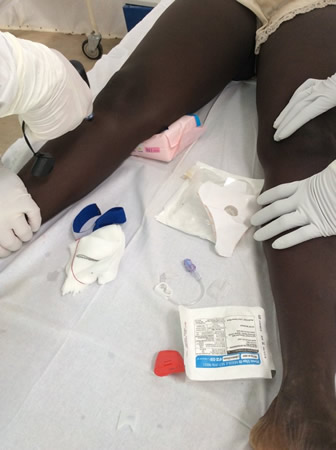
Sepsis/septic shock
Identification of sepsis or septic shock should be done rapidly using established criteria.
Management follows the same principles as for bacterial sepsis. Local guidance should be followed, but should include:[153]
Broad-spectrum empirical antibiotic therapy, ideally given within one hour of recognition
Rapid intravenous fluid resuscitation with assessment of response
Appropriate airway management and oxygen administration.
Broad-spectrum antibiotics are used in patients with infection to target the presumed translocation of gut organisms. This is not backed by any evidence, and blood cultures are difficult to do safely in infected patients. In some settings, especially in endemic areas where there is poor access to diagnostic tests, patients are routinely given broad-spectrum antibiotics as part of the management protocol.
Blood lactate levels are a useful tool to help assess perfusion and response to resuscitation.
In the absence of a response to initial management, inotropic support should be considered, preferably via a central venous catheter in an intensive care unit where invasive monitoring enables more aggressive fluid, electrolyte, and acid-base balance correction.[115][141]
The possibility of haemorrhage should be considered, particularly in patients with skin or mucosal bleeding.
WHO guidelines should be consulted for specific recommendations on the management of sepsis/septic shock.
WHO: optimized supportive care for Ebola virus disease Opens in new window
Significant bleeding/haemorrhage
Major bleeding occurs infrequently, but is a manifestation of advanced infection that is usually, but not always, fatal.
When available, fresh whole blood or platelet and plasma transfusions should be given according to local protocols and guided by clinical and laboratory (if available) indicators (e.g., haemoglobin, haematocrit, INR).[152][154][155]
Vitamin K, tranexamic acid, or a proton-pump inhibitor (for gastrointestinal bleeding) are reasonable treatment options in patients who are bleeding.[143][152]
Organ dysfunction
Multi-organ dysfunction is a common feature of advanced infection and includes acute kidney injury, pancreatitis, adrenal failure, and liver damage. Liver damage (e.g., hepatitis) is common; however, jaundice is not a common feature.[69] Renal dysfunction is common, but can be reversed with adequate fluid resuscitation in the initial stages.[69] In patients with anuria who do not respond to fluid resuscitation, renal replacement therapy has been used, although there are no trial data to support the efficacy of this intervention. Of the 5 critically ill patients in Europe and North America with multi-organ failure who were managed with both invasive mechanical ventilation and renal replacement therapy, 3 died.[45][107][134][136][156]
Convalescent whole blood or plasma
There is limited evidence from past outbreaks that transfusion of blood from convalescent patients could be beneficial in the acute phase of infection, and may reduce mortality.[6][157] Use of convalescent plasma is likely to be more achievable and effective than use of whole blood.[158][159] The WHO has issued interim guidelines on the use of convalescent blood/plasma. Trials carried out in Guinea failed to show a survival benefit in patients treated with convalescent plasma, although the treatment appeared to be safe with no severe complications documented.[160][161]
Antiviral therapy
Therapeutic antiviral monoclonal antibodies are available. The WHO strongly recommends either atoltivimab/maftivimab/odesivimab (also known as REGN-EB3) or ansuvimab (also known as mAb114) for patients with confirmed infection with Ebola virus (species Orthoebolavirus zairense), and neonates ≤7 days of age with unconfirmed infection who are born to mothers with confirmed infection with Ebola virus (species Orthoebolavirus zairense).[162]
Atoltivimab/maftivimab/odesivimab
An antibody cocktail consisting of three fully human monoclonal antibodies targeted at three non-overlapping Orthoebolavirus zairense glycoprotein epitopes. The three antibodies bind to the glycoprotein on the surface of the virus simultaneously and block the attachment and entry of the virus.
Approved by the Food and Drug Administration (FDA) for the treatment of infection with Ebola virus (species Orthoebolavirus zairense) in children and adults, and has received orphan drug designation from the European Medicines Agency.[144]
Evaluated in the PALM trial, a multi-center, open-label, randomised controlled trial, as well as part of an expanded access programme conducted in the Democratic Republic of the Congo (DRC) during the 2018 outbreak. The primary efficacy endpoint in the trial was 28-day mortality. Of the patients who received atoltivimab/maftivimab/odesivimab, 33.5% died at 28 days compared to 51% of patients in the control group (ZMapp).[163]
Ansuvimab
A human IgG1 monoclonal antibody targeted to the Ebola virus (species Orthoebolavirus zairense) glycoprotein. It was isolated from a human survivor of the 1995 outbreak in Kikwit (Democratic Republic of the Congo), and developed by the National Institutes of Health in the US.
Approved by the FDA for the treatment of infection with Ebola virus (species Orthoebolavirus zairense) in children and adults.[144]
The PALM trial found that ansuvimab was superior to ZMapp (see Emerging section) at reducing mortality. Of the patients who received ansuvimab, 35.1% died at 28 days compared to 49.7% of patients in the control group (ZMapp).[163]
Atoltivimab/maftivimab/odesivimab and ansuvimab probably reduce mortality compared with standard of care (moderate-certainty evidence), ZMapp, and remdesivir. However, they may have little or no effect on time to viral clearance. It is very uncertain whether they increase the risk of serious adverse events.[162][164] Efficacy has not been established for other species of orthoebolaviruses.
These treatments must not be used together and should be considered alternatives to each other. Both treatments are administered as a single dose intravenous infusion, and should be given as soon as possible after diagnosis. They may be used in older people, pregnant and breastfeeding women, and children and newborns. Access to these therapeutics is challenging in many parts of the world, and choice depends on availability. They may need to be used under a compassionate use framework during an outbreak.
Malaria co-infection
Malaria should be tested for and treated with appropriate antimalarial therapy if present while keeping in mind the patient's risk for Ebola disease and the possibility of a dual infection. In endemic settings, malaria treatment is usually given as part of the routine management protocol, with or without confirmation of the infection. Give empirical antimalarial therapy until the malaria testing is negative or the treatment course is finished.[143]
Pregnant women
Nearly all pregnant women in the outbreaks between 2014 and 2020 had adverse pregnancy outcomes, although the mortality rate in pregnant women was not higher than that of the nonpregnant patients.[165] However, in previous outbreaks, the reported case fatality rate has been higher in pregnant women compared with non-pregnant women.[166] Experience during the 2014 outbreak suggests that good outcomes can occasionally be achieved.[167]
Pregnant women who are not treated with investigational or compassionate use agents experience very high rates of spontaneous abortion, and fetal or neonatal death. Intrapartum haemorrhage and spontaneous abortion appear to be common; therefore, obstetric management should focus on monitoring for, and early treatment of, haemorrhagic complications.[21][166][168][169][170]
The WHO recommends the following key management principles:
Use both standard precautions and Ebola-specific infection prevention and control measures.
Include optimised supportive care in the clinical management of all pregnant women.
Atoltivimab/maftivimab/odesivimab and ansuvimab may be offered to pregnant women in the context of rigorous research, or in accordance with local protocols; however, this recommendation is based on very low-quality evidence.
Do not induce labour or perform invasive procedures for fetal indications in pregnant women with acute infection.
Advise women with suspected or confirmed acute infection not to breastfeed until after two negative breast milk tests (by reverse-transcription polymerase chain reaction [RT-PCR]) separated by 24 hours. In the meantime, infants should be separated from the mother and given a suitable breast milk substitute.
The CDC has also produced specific guidance for caring for pregnant women and neonates.
Children
Children should be managed by teams of health care workers with pediatric expertise. Planning for the care of children in non-endemic settings is complex and early involvement of intensivists has been advocated whenever feasible.[171][172][173]
Communication with family
Isolation in hospital affects the psychological wellbeing of patients, including increased rates of depression, anxiety, anger, fear, and loneliness. Healthcare workers should facilitate communication with family and friends (e.g., use of mobile phones or the internet) in order to reduce psychological distress without increasing the risk of infection.[145]
Use of this content is subject to our disclaimer

